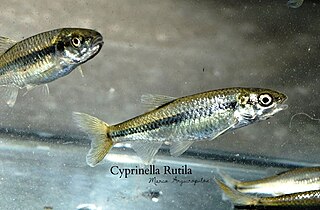The widemouth gambusia is a species of fish in the family Poeciliidae of the order Cyprinodontiformes. It is endemic to Mexico, specifically to the Baños del Azufre near Teapa, Tabasco. The Baños del Azufre are sulfidic springs that contain high concentrations of toxic hydrogen sulfide. This prevents most animals from living in them; the only other fish found in the toxic sections of Baños del Azufre is the sulphur molly.

Cyprinella is a genus of fish in the family Cyprinidae, the carps and minnows. They are known as the satinfin shiners. They are native to North America, and some are among the most common freshwater fish species on the eastern side of the continent. Conversely, several Cyprinella species with small distributions are threatened and the Maravillas Creek subspecies of the red shiner is extinct.
The largemouth shiner is a critically endangered species of cyprinid fish. It is found only in the Guzmán Basin in northwestern Chihuahua, Mexico, where it is called sardinita bocagrande. In 2012, it only survived in a single spring, which also was the last remaining habitat for the Carbonera pupfish and the dwarf crayfish Cambarellus chihuahuae. As this single spring was declining, it was decided to move some individuals of all three species to a nearby refuge in 2014 as a safeguard. The largemouth shiner grows to a standard length of 4.1 cm (1.6 in).

The blue shiner is a species of fish in the carp family. It is native to the southeastern United States, where it is endemic to the Cahaba and Coosa River systems of the Mobile River Basin. This is a federally listed threatened species under the Endangered Species Act of the United States.
The Cuatro Cienegas shiner is a species of freshwater fish in the family Cyprinidae.
The sulphur molly, locally known as molly del Teapa, is a critically endangered species of fish in the family Poeciliidae. It is endemic to Mexico, specifically to the Baños del Azufre near Teapa, Tabasco. The Baños del Azufre are sulfidic springs that contain high concentrations of toxic hydrogen sulfide. Poecilia sulphuraria has apparently evolved the ability to tolerate the toxic conditions. A few other Poecilia species are known from similar habitats in Mexico.
The bluntface shiner is a species of fish in the carp family, Cyprinidae. It is native to the United States, where it occurs in two disjunct populations on either side of the Mississippi River. It is a common fish in its range, even abundant in some localities.
Spotfin chub is a ray-finned fish in the family Cyprinidae that is endemic to the Tennessee River watershed. Its other common names include turquoise shiner and chromium shiner.
The Ocmulgee shiner is a species of fish in the family Cyprinidae. It is endemic to the United States where it occurs in the Altamaha and Ogeechee river drainages in Georgia.
The greenfin shiner is a species of fish in the family Cyprinidae. It is endemic to the United States, where it occurs in the Santee River drainage in North Carolina and South Carolina, and the Peedee River drainage in South Carolina.
The gibbous shiner is a species of fish in the family Cyprinidae. It is endemic to Mexico.
The Tallapoosa shiner is a species of fish in the family Cyprinidae. It is endemic to the United States, where it occurs in the Tallapoosa River system in Alabama and Georgia.
The thicklip chub is a species of fish in the family Cyprinidae. It is endemic to the United States, where it occurs in the Blue Ridge foothill and typical Piedmont sections of the Pee Dee and Santee drainages in North Carolina and South Carolina.
The bannerfin shiner is a species of fish in the family Cyprinidae. It is endemic to the United States, where it occurs on the Atlantic Slope from the Edisto River drainage in South Carolina to the Altamaha River drainage in Georgia. It also occurs on the Gulf Slope in the Suwannee and the Oklockonee drainages in southern Georgia and northern Florida.
The Plateau shiner is a species of fish in the family Cyprinidae. It is endemic to the United States, where it occurs on the Edwards Plateau in Texas where it inhabits the upper Guadalupe and Nueces River drainages.
The whitefin shiner is a species of fish in the family Cyprinidae. It is endemic to the United States, where it occurs on the Atlantic Slope from the Neuse River drainage in North Carolina to the Savannah River drainage in Georgia.
The fieryblack shiner is a species of fish in the family Cyprinidae. It is endemic to the United States, where it occurs in the Santee and Pee Dee river drainages in North and South Carolina.

The Mexican red shiner is a species of fish in the family Cyprinidae. It is endemic to Mexico.
The Altamaha shiner is a species of fish in the family Cyprinidae. It is endemic to the United States, where it occurs in the upper areas of the Altamaha River drainage, primarily above the Fall Line in north-central Georgia.
The Santee chub is a species of fish in the family Cyprinidae. It is endemic to the United States, where it occurs in the Cape Fear, Pee Dee, and upper Santee river drainages in North and South Carolina.





